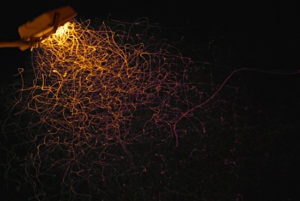Another cold night on Tuesday. Also another club meeting. We were missing our rolling table for the projector, but managed to acquire a huge printer that we’re not allowed to use.
 |
| Bugs flying near a street light. |
Long exposure prints were handed in by those who braved the topic. It was difficult for many, due to the rarity of doing such shots in our normal day-to-day shooting. A huge congratulations to anyone who submitted, especially if you found yourself stepping away from your usual comfort zone to do so. For anyone who didn’t submit, I encourage you to experiment with long exposure at your own leisure, as it really is worth learning.
Reminder: Thad Kubis will be judging Long Exposure on the 13th (that’s this Tuesday, not the 20th).
Bruce did his workshop on “Steps in the Printing of a Photograph.” I’ll only provide a very bare bones description here, as he has made his presentation available to us in PDF. Links below.
In a nutshell:
- Bruce started by discussing the why and how of monitor calibration. Also, choosing a color space (sRGB, Adobe RGB, etc…). Not being in control of these two factors is what often leads to prints looking different that what you see on your monitor. Ever print an image and wonder why you get dark muck or the wrong colors? This is likely why.
- Bruce continued by talking JPG/RAW, or more specifically, 8-bit vs 16-bit. He encourages people to use all the data available to them, rather than giving up flexibility and detail. This was re-emphasized when the discussion moved to dpi.
- He walked us through his own process, settings, etc… He provided sample prints on different paper types, at different dpi, and explained what soft proofing (as many of us never use it).
- He emphasized the importance of printing from Photoshop (or whatever editor you use), rather than letting Windows be in charge of making the decisions for you.
- The PDF – This is the presentation itself. It includes screenshots and descriptions/notes of what’s going on in each.
- Printer Evaluation Images – A PSD file (open in Photoshop) including color palettes, highlight/shadow grids, and sample images mostly checking for contrast and color.
- Hmm… There’s also a TIF file (Twenty-Eight Balls), but it doesn’t seem to open proper. Maybe corrupted? I’ll check in with Bruce and update this as needed. The image is visible in the PDF though.